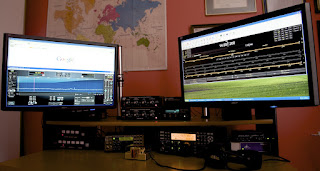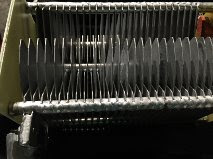Posts Tagged ‘Condo ham radio’
 Slow time on the bands.
Slow time on the bands.
I took an extra few days off over the Easter weekend with the intention of getting some solid radio time in. As it turned out the only day I had was yesterday afternoon most likely because I knew my vacation was coming to an end and the plan was to get on the rig! I was planning on doing some JT-65 as with the solar conditions not so great and my 5 watts signal to boot it seemed to be the logical move. Before getting on the radio I looked up a website called Band conditions. This is a very nice site that gives you up to date band conditions via nice easy to read bar type graphs. Each HF band is displayed and is update automatically every 30 seconds. There is an arrow for each band graph that is either in the Red, Yellow or green portion of the bar graph……you can guess what color means what. Seeing that 20m and 30m seemed to be the go to bands I booted up WSJT-X and ended up finding 30m not so great but 20m was booming with lots of European stations. Unfortunately my calling CQ was not being answered. I did check with PSK reporter and my signal was being spotted all over the U.S as well as some places in Europe. I then closed down WSJT-X and opened Fldigi and now the plan was to give PSK 31 a whirl on 20m. I was not disappointed as there was lots of signals in the waterfall. After spending about 45 min’s on the band I only was able to get the attention of one Spanish station to hear my QRP signal……BUT conditions seemed to change and we never completed the QSO. One thing I took away from the time on the radio is that I have to review what PSK-31 macro’s and simplify some and rename some of the buttons to make them more user friendly to me.
 Can this be done??
Can this be done??
I have been using a PC program called Morse runner and going to the LCWO website to increase my contest cw receiving speed and keyboard skill. I wanted to take it up a notch to what I consider a must have contest skill. The skill I am referring to is the ability to exchange contest info with my Iambic key ( Begali Contour) and not only the keyboard. Both Morse Runner and the tools from the LCWO site have been a great help with improving my keyboard and receiving speed and moving it forward. What I'm looking for and asking my blog readers input on is......a PC program similar to Morse Runner were I can use my key to interact with the program. Morse Runner sends you a call, you enter the call in the program (it checks you have enter proper call) then a contest report comes your way you enter it and the program sends your report. If all the info checks out as correct you are able to move on the the next contact. Does anyone know of a PC program out there were I can use my key and not keyboard to brush up on my key proficiency within a contest environment.
Oh and by the way of a radio report..... I was on the rig yesterday not much going on the CW portion of 20m and 30m during the early part of the afternoon. I ventured back around 22:00 UTC and 20m was sending some DX my way. Some of the stations heard but I was unable to contact were LZ300MSP (that call is a key full), T77CS, EA3AIZ from Spain struggled to hear my QRP signal but there was just to much QSB at his end. All was not lost DL3DXX heard me in Germany and gave me a 559 report.
Oh and by the way of a radio report..... I was on the rig yesterday not much going on the CW portion of 20m and 30m during the early part of the afternoon. I ventured back around 22:00 UTC and 20m was sending some DX my way. Some of the stations heard but I was unable to contact were LZ300MSP (that call is a key full), T77CS, EA3AIZ from Spain struggled to hear my QRP signal but there was just to much QSB at his end. All was not lost DL3DXX heard me in Germany and gave me a 559 report.
 MFJ 1788 vs Weather
MFJ 1788 vs Weather
As like everywhere else it seems the weather up this way is as up and down as the solar conditions! Up this way we have been breaking records with both high and sometimes low temps. Along with this crazy weather comes conditions that can be very hard on our antenna systems. I have read on many blogs of fellow hams dealing with antenna damage due to wind, ice and heavy snow issues. My antenna foot print is a very small one and so I thought sheltered from many of the issues others have been dealing with. Here is my weather related antenna issue to add to the list of weather mishaps. On Wednesday this week Julie and I came home from work and she announced (as she was looking outside) “your not going to like this”. Not very comforting words as I had a look for myself and saw that the high winds had their way with my antenna! I have an MFJ 1788 mag loop antenna. It’s mounted on a tripod on our balcony of the condo. The wind had toppled it on it’s side and then tossed all around the balcony as well. I understand to most of the other hams out there with weather damaged antennas, mine is a walk in the park. In my humble opinion this is the only antenna I have, it’s not cheap to replace and I am very limited on my antenna choices. As a side note I usually place the antenna off to the side when not in use and that way it is totally sheltered from the elements. I admit I was lazy and figured it had been ok for a week with the antenna in that position………..WRONG! I stood the antenna back upright and there seemed to be no broken parts all was in tacked. I crossed my fingers turned on the K3 and gave the antenna a go, the lowest the SWR would go was 4.0:1 and higher on other bands……not good. Below are the steps I went through to eventually fixing the antenna:
In the above picture the 3rd fin from the left was perfect centre and all others had to match.
2 2. I then inspected the PL-259 connector just to make sure it was fine and not on it’s way out due to unforeseen damage. It was ok as well.
3 3. I then brought in the MFJ 1788 antenna into the house and first had a look over of the outside case, SO-259 and the antenna loop. All seemed good this way.
4 4. It was now time to open up the plastic housing and have a look inside, I have had the antenna apart on occasion for routine maintenance so I had an idea of how things should look. There was no obvious signs of damage to any of the major parts.
5 5. It was now time to connect the coax and run the internal variable capacitor to the end of each stop via the control box.
Here is where I noticed two problems:
· A.The spacing between the stationary fins and rotating fins was not equal at certain points along the variable capacitor.
· B. When the capacitor was fully seated in one direction both the stationary fins and rotating fins should sit flush with each other and some on the rotating section were sitting higher.
To fix the spacing problem (which I had to do then the antenna was shipped to me) I used a screw driver to manipulate the fins to even up all the air gap between fins. To repair the fins that were not sitting flush I was able to loosen a nut on the shaft that held all the moving capacitor fins in place. I then was able to adjust the fins that were sitting to high and make them all flush.
It's hard to see but from the left about 7 fins over the next five fins start to look odd, this is because these fins are not sitting flush with the other fins and they had to be adjusted so they were flush.
1 6. It was not time to cross my fingers and try the antenna (with plastic cover off) and see if this was in fact the problem. I was able to turn the antenna to 1.1:1- 1.1:4 on all bands and this was with the antenna sitting on a table in my living room. It seems the problem was fixed!
2
7. I then put the plastic cover back on and again check the SWR on all bands, I wanted to make sure nothing changed……. nothing did change and all was still good.
7. I then put the plastic cover back on and again check the SWR on all bands, I wanted to make sure nothing changed……. nothing did change and all was still good.
3 8. I then re-mounted the antenna on the tripod and covered it with my canvas patio table cover….so it does not “look” like an antenna. I then tested the SWR again…it was now 8:1!!
4 9. I then removed the canvas cover and the SWR was fine again…..seems canvas was damp do to the rain that accompanied the wind that day. I put the cover in the dryer and then back on the antenna and all was well. I am now going to purchase some waterproofing spray for the canvas to keep the antenna dry.
Below is one section of the fins that have been adjusted and are back to normal position.
Below is one section of the fins that have been adjusted and are back to normal position.
 ARRL DX CW contest done for 2016
ARRL DX CW contest done for 2016
| The roll top radio desk |
| The contest desktop |
 Multi tasking at the rig.
Multi tasking at the rig.
| Reading blogs and operating JT65-HF |
 CQ contest this weekend.
CQ contest this weekend.
 |
| Ahhh the old setup along with a great antenna............ |
1. Stay with the contest and not to get frustrated.
2. Try not to use the morse code reader and do most by ear....see how that works out.
3. Have fun and not worry about the score as with my setup placing anywhere for anything is most likely out of the question.
I will keep you posted as to how things go in the contest.....oh and the new setup as well....maybe I will hang some garlic close to the shack to keep Murphy away....:)
 Time to look inside the MFJ 1788
Time to look inside the MFJ 1788
| Taking a close look at things |
| Checking the cap fins |
| Some of the many nuts that were very loose. |
| Control wire torn off. |














